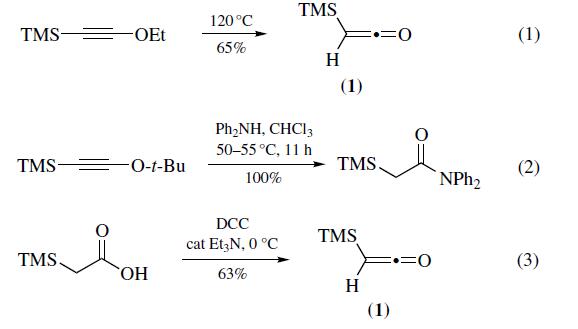Trimethylsilylketene
|
|
|
- CAS-Nr.
- 4071-85-6
- Englisch Name:
- Trimethylsilylketene
- Synonyma:
- Trimethylsilylketene;(Trimethylsilyl)ketene;(trimethylsilyl)-ethenon;2-trimethylsilylethenone;(TRIMETHYLSILYL)KETENE 97;(TRIMETHYLSILYL)KETENE 97%;Ethenone, 2-(trimethylsilyl)-;2-(Trimethylsilyl)ethene-1-one
- CBNumber:
- CB1500224
- Summenformel:
- C5H10OSi
- Molgewicht:
- 114.22
- MOL-Datei:
- 4071-85-6.mol
|
Trimethylsilylketene Eigenschaften
- Siedepunkt:
- 80-82 °C(lit.)
- Dichte
- 0.813 g/mL at 25 °C(lit.)
- Brechungsindex
- n20/D 1.413(lit.)
- Flammpunkt:
- 3 °F
- Löslichkeit
- Sol CH2Cl2, CHCl3, CCl4, THF, diethyl ether, and
most standard organic solvents; reacts with alcoholic and amine
solvents.
- EPA chemische Informationen
- Ethenone, (trimethylsilyl)- (4071-85-6)
Sicherheit
- Risiko- und Sicherheitserklärung
- Gefahreninformationscode (GHS)
| Kennzeichnung gefährlicher |
F |
|
|
| R-Sätze: |
11 |
|
|
| S-Sätze: |
7/9-16-29-33 |
|
|
| RIDADR |
UN 1993 3/PG 2 |
|
|
| WGK Germany |
3 |
|
|
| Bildanzeige (GHS) |

|
| Alarmwort |
Achtung |
| Gefahrenhinweise |
| Code |
Gefahrenhinweise |
Gefahrenklasse |
Abteilung |
Alarmwort |
Symbol |
P-Code |
| H225 |
Flüssigkeit und Dampf leicht entzündbar. |
Entzündbare Flüssigkeiten |
Kategorie 2 |
Achtung |
![GHS hazard pictograms]() src="/GHS02.jpg" width="20" height="20" /> src="/GHS02.jpg" width="20" height="20" /> |
P210,P233, P240, P241, P242, P243,P280, P303+ P361+P353, P370+P378,P403+P235, P501 |
|
| Sicherheit |
| P210 |
Von Hitze, heißen Oberflächen, Funken, offenen Flammen und anderen Zündquellenarten fernhalten. Nicht rauchen. |
| P233 |
Behälter dicht verschlossen halten. |
| P240 |
Behälter und zu befüllende Anlage erden. |
| P241 |
Explosionsgeschützte [elektrische/Lüftungs-/ Beleuchtungs-/...] Geräte verwenden. |
| P242 |
Nur funkenfreies Werkzeug verwenden. |
| P243 |
Maßnahmen gegen elektrostatische Entladungen treffen. |
| P280 |
Schutzhandschuhe/Schutzkleidung/Augenschutz tragen. |
| P303+P361+P353 |
BEI BERÜHRUNG MIT DER HAUT (oder dem Haar): Alle kontaminierten Kleidungsstücke sofort ausziehen. Haut mit Wasser abwaschen oder duschen. |
| P370+P378 |
Bei Brand: zum Löschen verwenden. |
| P403+P235 |
An einem gut belüfteten Ort aufbewahren. Kühl halten. |
| P501 |
Inhalt/Behälter ... (Entsorgungsvorschriften vom Hersteller anzugeben) zuführen. |
|
Trimethylsilylketene Chemische Eigenschaften,Einsatz,Produktion Methoden
R-Sätze Betriebsanweisung:
R11:Leichtentzündlich.
Physikalische Eigenschaften
bp 81–82 °C; d 0.80 g cm?3.
Verwenden
Trimethylsilylketene is a reactive acylating agent for amines and alcohols; building block
for synthesis of coumarins; synthesis of α-silyl ketones via
the addition of organocerium reagents; treatment with stabilized
ylides forms trimethylsilyl-substituted allenes;a cycloaddition
with aldehydes affords β-lactones; forms small rings with
diazomethane; treatment with n-BuLi forms a ketene enolate. It participates in the reactions of Trimethylsilylacetylation of Alcohols and Amines, Synthesis of Coumarins via Cyclization–Elimination, One-pot Formation of α-Silyl Ketones, Preparation of Trimethylsilyl-Substituted Allenes, Preparation of β-Lactones, Reaction with Diazomethane to Form Silylated Cyclopropanes
and Cyclobutanones, Synthesis of Heterocycles, Formation of the Ketene Enolate, and other uses.
synthetische
Most often prepared (eq 1) by pyrolysis
of ethoxy(trimethylsilyl)acetylene at 120??C (100 mmol scale,
65% yield).Recently, pyrolysis of t-butoxy(trimethylsilyl)
acetylene has been shown to be a convenient alternative for
the preparation of trimethylsilylketene (1). Thermal decomposition
of t-butoxy(trimethylsilyl)acetylene causes elimination
of 2-methylpropene slowly at temperatures as low as 50??C and
instantaneously at 100¨C110??C (30 mmol scale, 63% yield).
The main advantage of this method is that it is possible to generate
trimethylsilylketene in the presence of nucleophiles, leading
to in situ trimethylsilylacetylation (eq 2). Increased shielding
of the triple bond prevents problems such as polymerization
and nucleophilic attack that occur when the ketene is generated
in situ from (trimethylsilyl)ethoxyacetylene. Trimethylsilylketene
can also be prepared (eq 3) via the dehydration
of commercially available trimethylsilylacetic acid with 1,3-
dicyclohexylcarbodiimide (DCC) in the presence of a catalytic
amount of triethylamine (100 mmol scale, 63%). Other
typical methods used for ketene generation such as dehydrohalogenation
of the acyl chloride and pyrolysis of the
anhydride have been applied to the preparation of (1);
however, both methods afford low yields.

There have been no significant developments in the methods
used to prepare trimethylsilylketene (TMSK). However,
Black et al. have published slight modifications. to the original
preparation by Ruden, which primarily deals with accessing
ethoxyacetylene.
Trimethylsilylketene Upstream-Materialien And Downstream Produkte
Upstream-Materialien
Downstream Produkte
Trimethylsilylketene Anbieter Lieferant Produzent Hersteller Vertrieb Händler.
Global( 9)Lieferanten
4071-85-6()Verwandte Suche:
- (TRIMETHYLSILYL)KETENE 97%
- (Trimethylsilyl)ketene
- Trimethylsilylketene
- 2-(Trimethylsilyl)ethene-1-one
- 2-trimethylsilylethenone
- (trimethylsilyl)-ethenon
- (TRIMETHYLSILYL)KETENE 97
- Ethenone, 2-(trimethylsilyl)-
- 4071-85-6
- CH33SiCHCO
- Carbonyl Compounds
- Organic Building Blocks
- Others

